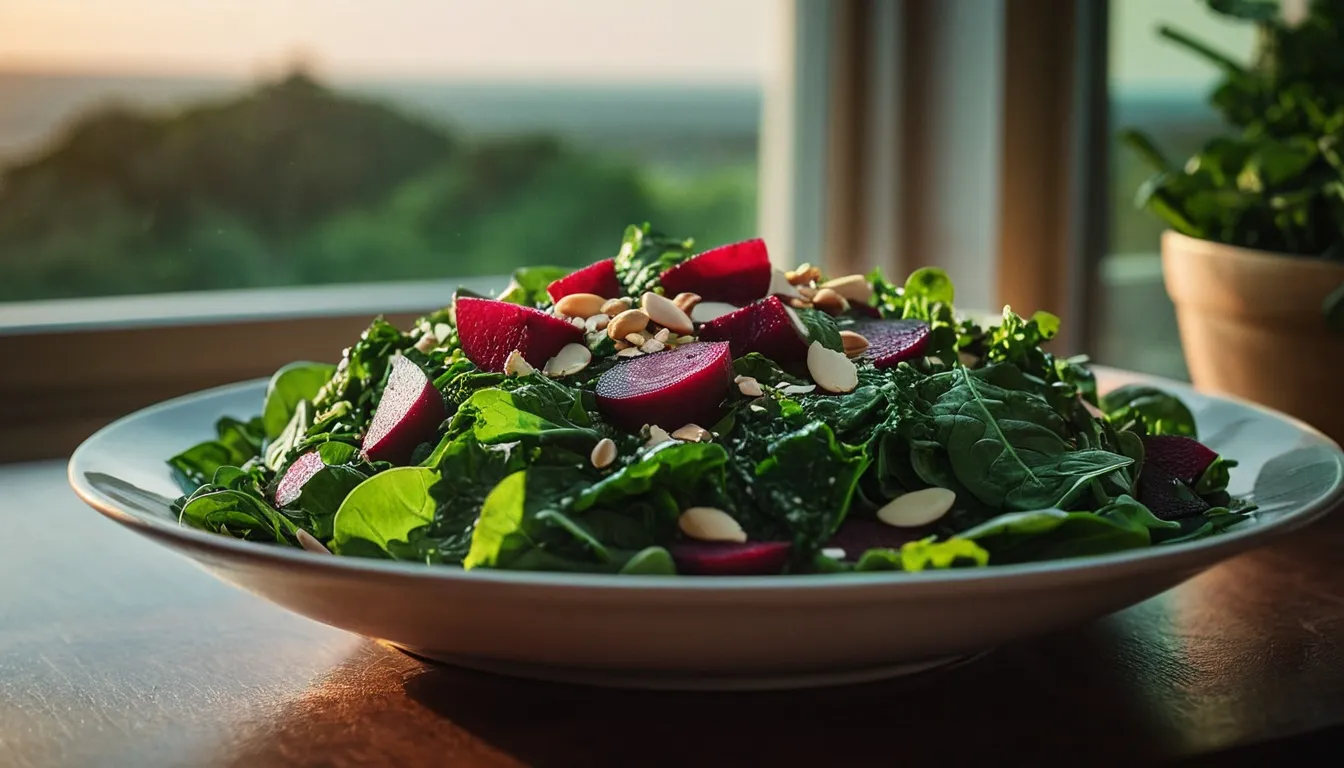
Why Your Spinach Salad Might Be Plotting Against You: The Oxalate Conspiracy
Is your healthy diet sabotaging you? Uncover the truth about oxalates in almonds, spinach, and more, and learn how to avoid common oxalate-related health risks.
Why Your Spinach Salad Might Be Plotting Against You: The Oxalate Conspiracy
So, you’ve decided to eat healthier—kudos! You’ve loaded up your cart with all the superfoods you can find: kale, spinach, almonds, blueberries and even some fancy herbal teas. But what if I told you that these seemingly innocent foods might be secretly plotting against you? Yep, that’s right—these nutrient-packed goodies could be high in oxalates, those tiny troublemakers that can cause more harm than good if you’re not careful. Let’s dive into the oxalate conspiracy and uncover what’s really going on in your veggie drawer.
What the Heck Are Oxalates, Anyway?
Oxalates are naturally occurring compounds found in many plants, including some of your favorite superfoods. While they’re not inherently evil, oxalates can bind minerals in the digestive tract, forming pesky little crystals. Over time, these crystals can lead to kidney stones, joint pain, and other health issues. In short, oxalates are the frenemies of the health food world—seemingly beneficial, but capable of wreaking havoc if left unchecked.
The Unusual Suspects: Foods High in Oxalates
Beware! Here are some common foods that are particularly high in oxalates:
- Kale: Yes, your beloved kale. The poster child of superfoods is also packing a decent amount of oxalates.
- Spinach: Another leafy green with a dark side. Spinach is one of the highest oxalate-containing foods.
- Almonds: A handful of almonds might be your go-to snack, but they’re also loaded with oxalates.
- Beets: While great for your blood pressure, beets are notorious for their high oxalate content.
- Sweet Potatoes: Delicious and nutritious, but also a sneaky source of oxalates.
- Rhubarb: This tart vegetable is often used in desserts but is surprisingly high in oxalates.
- Chard: Another leafy green that’s rich in nutrients—and oxalates.
- Soy Products: Tofu, soy milk, and other soy-based foods can be high in oxalates.
- Nuts: In addition to almonds, peanuts, cashews, and walnuts are also high in oxalates.
- Blackberries: These berries might be tasty, but they come with a hefty dose of oxalates.
- Buckwheat: A popular grain alternative that’s high in oxalates.
- Okra: Often used in soups and stews, okra is another oxalate-rich food.
- Quinoa: This trendy grain substitute is healthy, but it’s also high in oxalates.
- Chocolate: Sadly, chocolate is a high-oxalate food, especially dark chocolate.
- Potatoes: Regular white potatoes, especially when baked, have a significant oxalate content.
How to Outsmart the Oxalates
Now that you know where these sneaky oxalates are hiding, how do you avoid them without sacrificing your healthy diet? Here’s the lowdown:
- Balance Is Key: Don’t eliminate oxalate-rich foods entirely. Instead, balance your diet by including low-oxalate options like cauliflower, cucumbers, and cabbage.
- Pair with Dairy: Calcium is the oxalate’s arch-nemesis. By pairing oxalate-rich foods with dairy products like cheese or yogurt, you can help neutralize the oxalates and reduce their absorption. So, go ahead and sprinkle some cheese on that spinach salad!
- Cook Smart: Boiling or steaming oxalate-rich vegetables can reduce their oxalate content. For example, boiling spinach can cut its oxalate levels nearly in half.
Sip with Caution: Teas and Drinks to Avoid
You might want to think twice before reaching for that cup of herbal tea. Certain teas, especially black and green teas, are high in oxalates. And if you’re a fan of iced tea, brace yourself—those cold brews can pack a serious oxalate punch. Instead, opt for herbal teas like chamomile or peppermint, which are much lower in oxalates. Oh, and remember to steer clear of cranberry juice—it’s another high-oxalate culprit.
The Not-So-Fun Part: Symptoms of Oxalate Damage
If you’re consuming too many oxalates, your body might start sending out distress signals. Here are some symptoms that could indicate oxalate overload:
- Kidney Stones: The most infamous result of oxalate buildup. If you’ve ever had one, you know the agony.
- Joint Pain: Those oxalate crystals can deposit in your joints, causing pain and discomfort.
- Fatigue: Excess oxalates can interfere with nutrient absorption, leaving you feeling tired and rundown.
- Gut Issues: Oxalates can irritate the gut lining, leading to digestive discomfort.
Diets That Address Oxalate Issues: Navigating the Oxalate Maze
If you’re concerned about oxalates and their potential impact on your health, you might be wondering if there’s a way to eat that minimizes these tiny troublemakers. Fortunately, there are several diets designed to reduce oxalate intake or avoid it altogether. Let’s explore some popular diets that tackle oxalate issues head-on.
1. The Carnivore Diet: An Oxalate-Free Zone
The Carnivore Diet is the ultimate oxalate-free diet. By focusing exclusively on animal products—meat, fish, eggs, and some dairy—this diet naturally eliminates all plant-based foods, including those high in oxalates. Since oxalates are only found in plant foods, the Carnivore Diet is often recommended for individuals dealing with severe oxalate issues, like recurring kidney stones or chronic pain conditions.
Pros:
- Completely eliminates oxalates.
- Can be effective for managing symptoms related to oxalate overload.
- High in protein and essential nutrients from animal products.
Cons:
- Lacks variety, as it excludes all plant-based foods.
- May be difficult to sustain long-term for some people.
- Requires careful planning to ensure balanced nutrition.
2. The Low-Oxalate Diet: Managing Oxalates Without Going Extreme
A Low-Oxalate Diet is less restrictive than the Carnivore Diet and allows for the inclusion of low-oxalate fruits, vegetables, and grains. This diet focuses on reducing overall oxalate intake by avoiding or limiting high-oxalate foods like spinach, almonds, and beets. It’s a more balanced approach that can be easier to maintain while still addressing oxalate concerns.
Pros:
- Reduces oxalate intake without eliminating entire food groups.
- Allows for a more diverse and balanced diet.
- Easier to follow for most people.
Cons:
- Requires knowledge of oxalate content in foods.
- Some foods may still need to be avoided or limited.
3. The Ketogenic Diet: Low in Oxalates, High in Fat
The Ketogenic Diet, or Keto, is a high-fat, low-carbohydrate diet that can also be adapted to reduce oxalate intake. By focusing on low-oxalate vegetables (like cauliflower and zucchini), moderate protein from animal sources, and plenty of healthy fats, the Keto Diet can help minimize oxalates while supporting weight loss and other health goals.
Pros:
- Can be tailored to reduce oxalate intake.
- Promotes weight loss and improved metabolic health.
- Supports a high-fat, low-carb lifestyle.
Cons:
- May still include some oxalate-containing foods, depending on the specific approach.
- Requires careful planning to ensure a low-oxalate, high-fat balance.
- Not suitable for everyone, especially those with certain medical conditions.
4. The Paleo Diet: A Primal Approach to Lowering Oxalates
The Paleo Diet, inspired by the diet of our ancient ancestors, focuses on whole, unprocessed foods like meat, fish, vegetables, fruits, and nuts. While it includes some oxalate-rich foods (like nuts and certain vegetables), it’s generally lower in oxalates compared to a standard modern diet. By emphasizing quality animal proteins and low-oxalate vegetables, the Paleo Diet can be a good option for those looking to reduce oxalate intake without going to extremes.
Pros:
- Encourages whole, unprocessed foods.
- Can be adapted to reduce oxalate intake.
- Supports overall health and wellness.
Cons:
- May still include some moderate-to-high oxalate foods.
- Requires careful selection of vegetables and fruits.
- Can be restrictive for some people.
Finding the Right Diet for You
When it comes to managing oxalate issues, there’s no one-size-fits-all solution. The best diet for you will depend on your individual health needs, lifestyle, and preferences. Whether you choose to go full carnivore, follow a low-oxalate plan, or adapt a ketogenic or paleo approach, the key is to find a sustainable way to keep oxalates in check while still enjoying a varied and nutritious diet.
Before making any major dietary changes, it’s always a good idea to consult with a healthcare professional, especially if you have existing health conditions or concerns about nutrient deficiencies. With the right approach, you can outsmart those sneaky oxalates and keep your diet on track for optimal health.
Disclaimer
If you suspect you have an oxalate issue or are experiencing any symptoms, please consult a healthcare professional.
Recommended Reading: Books on Oxalates
If you’re curious to learn more about oxalates and how they can impact your health, here are some highly-rated books available on Amazon:
- “Toxic Superfoods: How Oxalate Overload is Making You Sick--and How to Get Better” by Sally K. Norton
- “The Ultimate Low Oxalate Diet Cookbook” by Gregory K. Hayer
- “The Low-Oxalate Anti-Inflammatory Cookbook” by Cindy Bokma
- “Plants Biting Back: Oxalates, Inflammation and the Problem with Modern Vegetable-Heavy Eating” by Omolola Habib
References: The Science Behind the Claims
If you’re a research enthusiast, here’s a list of studies and articles that dive into the science of oxalates:
- National Institutes of Health (NIH) – Oxalate Content of Foods
- Dietary Oxalate and Kidney Stone Formation – NIH
- The Role of Dietary Oxalate in Kidney Stone Formation
- Oxalate (dys) Metabolism: Person-to-Person Variability, Kidney and Cardiometabolic Toxicity (NIH)
Remember, while oxalates can be a sneaky adversary, with a bit of knowledge and some strategic dietary changes, you can keep them in check and continue enjoying your favorite superfoods—minus the drama!





